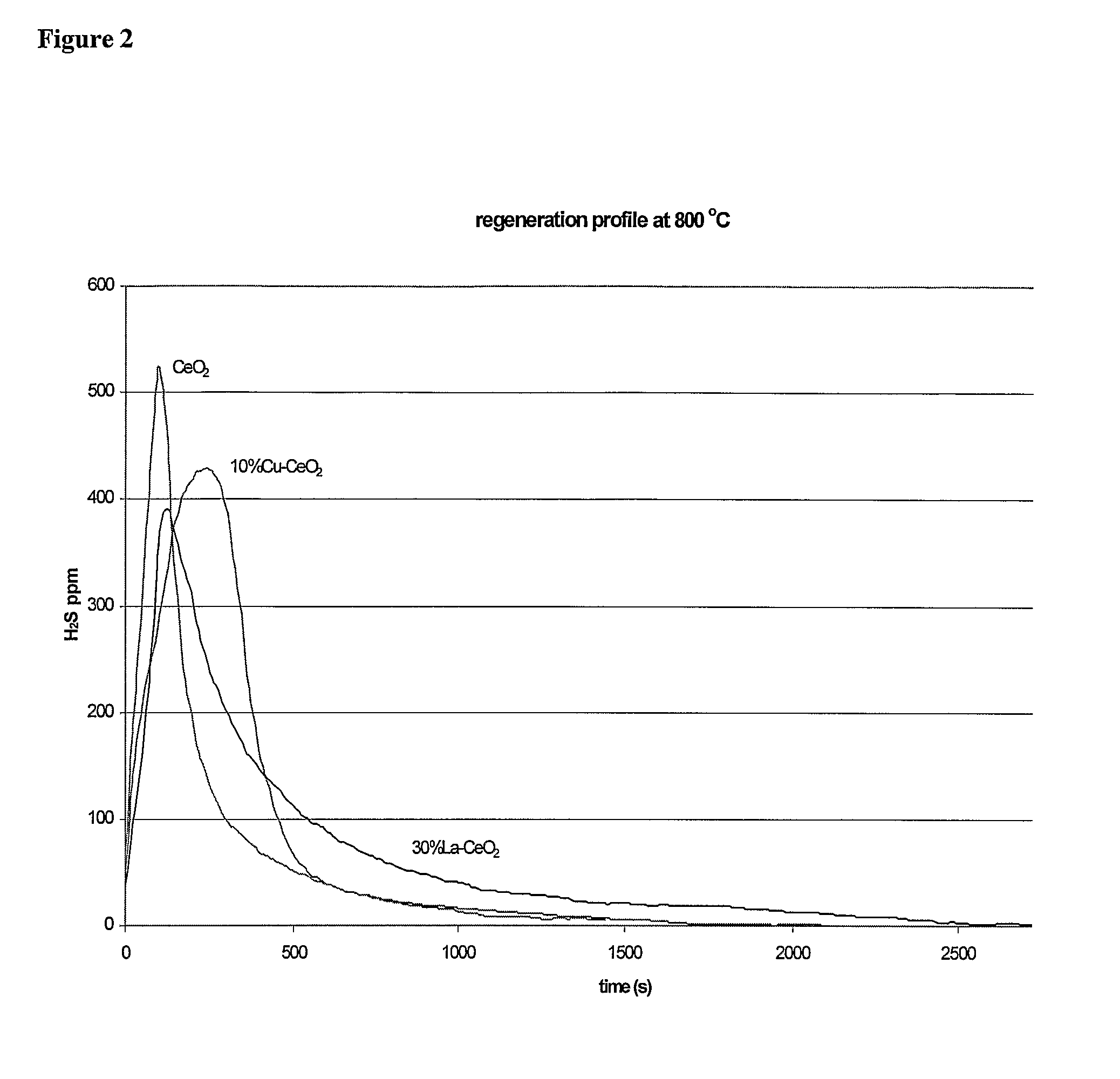Apparatus and methods for non-regenerative and regenerative hot gas desulfurization
a technology of non-regenerative and regenerative hot gas desulfurization, applied in the direction of combustible gas purification/modification, separation processes, electrochemical generators, etc., can solve the problems of low sulfur capacity, slow diffusion inwards, implementation, etc., and achieve the effect of reducing sorbent and effective and regenerable removal of h2s
- Summary
- Abstract
- Description
- Claims
- Application Information
AI Technical Summary
Benefits of technology
Problems solved by technology
Method used
Image
Examples
example 1
[0335]Sorbent Preparation. Cerium (IV) oxide (ceria), and La2O3 or CuO— containing ceria materials were prepared by the urea coprecipitation / gelation method, using nitrate salt solutions in the desired atomic metal ratios. For example, to prepare 10% Cu—CeOx, 1.8 g copper (II) nitrate and 41.1 g ammonium cerium (IV) nitrate were mixed and dissolved in 600 mL DI-water. This gives an atomic ratio of Ce / Cu of 9:1. Excess urea (72 g) was added into the solution under constant stirring and boiling over a hot plate. After the precipitant was produced, DI-water was added to 800 mL, and the solution was kept boiling for 8 h. The precipitate was filtered, washed twice, then dried in vacuum at 120° C. for 12 h, and crushed to powder before calcination. Samples were heated to 650 or 750° C. in air at 2° C. / min, holding at the final temperature for 4 h. After calcination in air at 650° C. for 4 h, high surface area materials (80˜100 m2 / g) with nanosize ceria were obtained. See FIG. 33.
example 2
[0336]Cyclic regeneration performance of sulfided sorbents. Sulfidation and regeneration tests were run in a packed-bed, quartz-tube micro reactor to evaluate the sulfur capacity, efficiency, regenerability, and stability of the sorbents. The sorbents were prepared by the urea coprecipitation / gelation method. In a typical experiment, 0.34 grams of sorbent powder, sized to less than 53 microns, was loaded in the reactor and then heated to the desired temperature in He, an inert gas. To mimic the conditions in a fixed-bed sorber where most of the bed is initially exposed to sulfur-free gas, pre-reduction of the sorbents in H2S-free fuel gas at the selected sulfidation temperature was carried out prior to each sulfidation test. Then the sulfidation gas (50% H2, 0.1% H2S, 10% H2O balance He) was introduced to the sorbent. This gas contains an exaggerated amount of hydrogen, corresponding to the upper limit of the combined concentration of H2 and CO present in a reformate gas produced by...
example 3
[0337]Effect of space velocity on regeneration time. A 10% Cu—CeO2 sorbent underwent sulfidation / regeneration cycling under the following conditions. The sorbent was pre-reduced with a 50% H2, 10% H2O, and 40% helium mixture for 1 hr. This step was followed by sulfidation in a gas mixture of 0.1% H2S, 50% H2, 10% H2O, and the balance of helium gas stream to breakthrough of 30 ppm H2S. The sulfidation step was followed by a regeneration step comprising passing a 50% H2, 10% H2O, and balance of helium gas stream through the sorbents. The sulfidation and regeneration steps were repeated. Space velocities of 80,000 h−1 and 400,000 h−1 were compared.
PUM
| Property | Measurement | Unit |
|---|---|---|
| temperature | aaaaa | aaaaa |
| temperature | aaaaa | aaaaa |
| temperatures | aaaaa | aaaaa |
Abstract
Description
Claims
Application Information
 Login to View More
Login to View More - R&D
- Intellectual Property
- Life Sciences
- Materials
- Tech Scout
- Unparalleled Data Quality
- Higher Quality Content
- 60% Fewer Hallucinations
Browse by: Latest US Patents, China's latest patents, Technical Efficacy Thesaurus, Application Domain, Technology Topic, Popular Technical Reports.
© 2025 PatSnap. All rights reserved.Legal|Privacy policy|Modern Slavery Act Transparency Statement|Sitemap|About US| Contact US: help@patsnap.com



